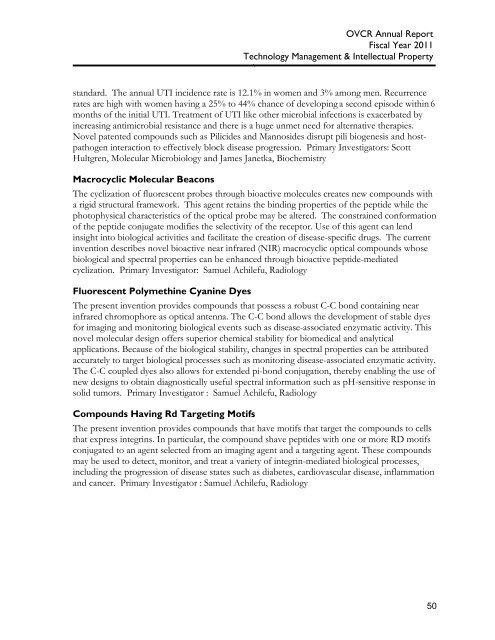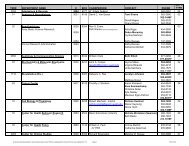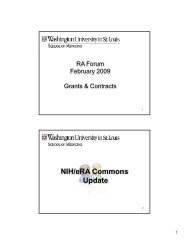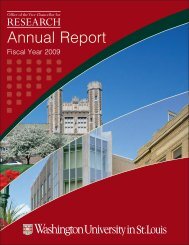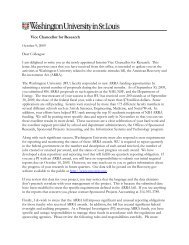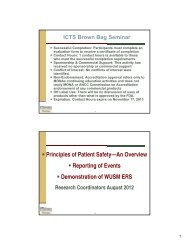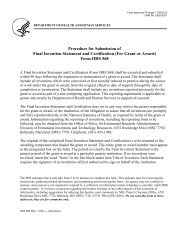A Letter from The Office of the Vice Chancellor for Research
A Letter from The Office of the Vice Chancellor for Research
A Letter from The Office of the Vice Chancellor for Research
You also want an ePaper? Increase the reach of your titles
YUMPU automatically turns print PDFs into web optimized ePapers that Google loves.
OVCR Annual ReportFiscal Year 2011Technology Management & Intellectual Propertystandard. <strong>The</strong> annual UTI incidence rate is 12.1% in women and 3% among men. Recurrencerates are high with women having a 25% to 44% chance <strong>of</strong> developing a second episode within 6months <strong>of</strong> <strong>the</strong> initial UTI. Treatment <strong>of</strong> UTI like o<strong>the</strong>r microbial infections is exacerbated byincreasing antimicrobial resistance and <strong>the</strong>re is a huge unmet need <strong>for</strong> alternative <strong>the</strong>rapies.Novel patented compounds such as Pilicides and Mannosides disrupt pili biogenesis and hostpathogeninteraction to effectively block disease progression. Primary Investigators: ScottHultgren, Molecular Microbiology and James Janetka, BiochemistryMacrocyclic Molecular Beacons<strong>The</strong> cyclization <strong>of</strong> fluorescent probes through bioactive molecules creates new compounds witha rigid structural framework. This agent retains <strong>the</strong> binding properties <strong>of</strong> <strong>the</strong> peptide while <strong>the</strong>photophysical characteristics <strong>of</strong> <strong>the</strong> optical probe may be altered. <strong>The</strong> constrained con<strong>for</strong>mation<strong>of</strong> <strong>the</strong> peptide conjugate modifies <strong>the</strong> selectivity <strong>of</strong> <strong>the</strong> receptor. Use <strong>of</strong> this agent can lendinsight into biological activities and facilitate <strong>the</strong> creation <strong>of</strong> disease-specific drugs. <strong>The</strong> currentinvention describes novel bioactive near infrared (NIR) macrocyclic optical compounds whosebiological and spectral properties can be enhanced through bioactive peptide-mediatedcyclization. Primary Investigator: Samuel Achilefu, RadiologyFluorescent Polymethine Cyanine Dyes<strong>The</strong> present invention provides compounds that possess a robust C-C bond containing nearinfrared chromophore as optical antenna. <strong>The</strong> C-C bond allows <strong>the</strong> development <strong>of</strong> stable dyes<strong>for</strong> imaging and monitoring biological events such as disease-associated enzymatic activity. Thisnovel molecular design <strong>of</strong>fers superior chemical stability <strong>for</strong> biomedical and analyticalapplications. Because <strong>of</strong> <strong>the</strong> biological stability, changes in spectral properties can be attributedaccurately to target biological processes such as monitoring disease-associated enzymatic activity.<strong>The</strong> C-C coupled dyes also allows <strong>for</strong> extended pi-bond conjugation, <strong>the</strong>reby enabling <strong>the</strong> use <strong>of</strong>new designs to obtain diagnostically useful spectral in<strong>for</strong>mation such as pH-sensitive response insolid tumors. Primary Investigator : Samuel Achilefu, RadiologyCompounds Having Rd Targeting Motifs<strong>The</strong> present invention provides compounds that have motifs that target <strong>the</strong> compounds to cellsthat express integrins. In particular, <strong>the</strong> compound shave peptides with one or more RD motifsconjugated to an agent selected <strong>from</strong> an imaging agent and a targeting agent. <strong>The</strong>se compoundsmay be used to detect, monitor, and treat a variety <strong>of</strong> integrin-mediated biological processes,including <strong>the</strong> progression <strong>of</strong> disease states such as diabetes, cardiovascular disease, inflammationand cancer. Primary Investigator : Samuel Achilefu, Radiology50


